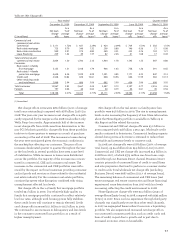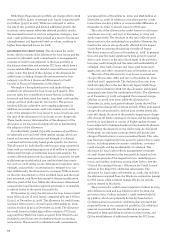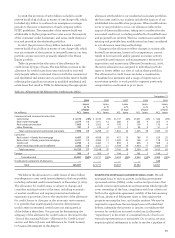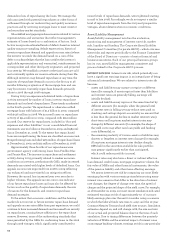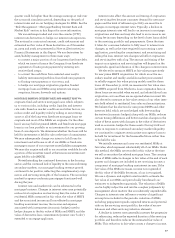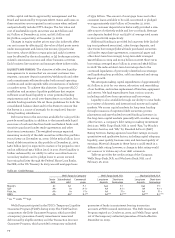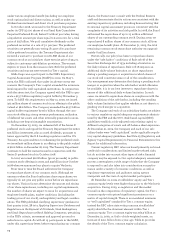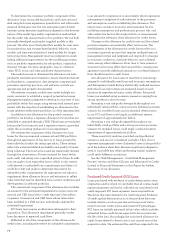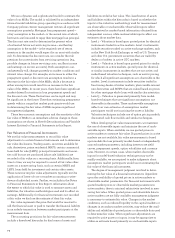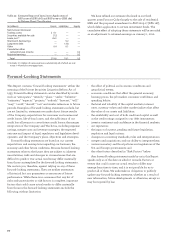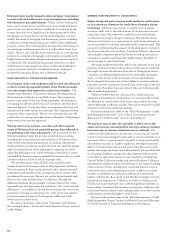Wells Fargo 2009 Annual Report Download - page 74
Download and view the complete annual report
Please find page 74 of the 2009 Wells Fargo annual report below. You can navigate through the pages in the report by either clicking on the pages listed below, or by using the keyword search tool below to find specific information within the annual report.
under various employee benefit (including our employee
stock option plan) and director plans, as well as under our
dividend reinvestment and direct stock purchase programs.
In October 2008, we issued to the Treasury Department
under its CPP 25,000 shares of our Fixed Rate Cumulative
Perpetual Preferred Stock, Series D without par value, having
a liquidation amount per share equal to $1,000,000, for a total
price of $25 billion. We paid cumulative dividends on the
preferred securities at a rate of 5% per year. The preferred
securities are generally non-voting. As part of its purchase
of the preferred securities, the Treasury Department also
received a warrant to purchase 110,261,688 shares of our
common stock at an initial per share exercise price of $34.01,
subject to customary anti-dilution provisions. The warrant
expires 10 years from the issuance date. Both the preferred
securities and warrant were treated as Tier 1 capital.
Wells Fargo was a participant in the FRB’s Supervisory
Capital Assessment Program (SCAP) in 2009. On May 7,
2009, the FRB confirmed that under its adverse stress test
scenario the Company’s Tier 1 capital exceeded the minimum
level required for well-capitalized institutions. In conjunction
with the stress test, the Company agreed with the FRB to gen-
erate a $13.7 billion regulatory capital buffer by November 9,
2009. To fulfill this requirement, on May 13, 2009, we issued
392 million shares of common stock in an offering to the public
valued at $8.6 billion. The Company exceeded the $13.7 billion
capital buffer requirement by $6.0 billion through the com-
mon stock offering, strong revenue performance, realization
of deferred tax assets and other internally generated sources,
including core deposit intangible amortization.
On December 23, 2009, we redeemed all of the Series D
preferred stock and repaid the Treasury Department the entire
$25 billion investment, plus accrued dividends, pursuant to
terms approved by the U.S. banking regulators and the U.S.
Treasury. As a precondition to redeeming the preferred stock,
we issued 490 million shares in an offering to the public valued
at $12.2 billion on December 18, 2009. The Treasury Department
continues to hold the warrant issued in conjunction with the
Series D preferred stock in October 2008.
In total, we issued $20.8 billion (gross proceeds) in public
common stock offerings in 2009, and $33 billion since October
2008 when we announced our plans to acquire Wachovia.
From time to time the Board authorizes the Company
to repurchase shares of our common stock. Although we
announce when the Board authorizes share repurchases, we
typically do not give any public notice before we repurchase
our shares. Various factors determine the amount and timing
of our share repurchases, including our capital requirements,
the number of shares we expect to issue for acquisitions and
employee benefit plans, market conditions (including the
trading price of our stock), and regulatory and legal consider-
ations. The FRB published clarifying supervisory guidance in
first quarter 2009, SR 09-4 Applying Supervisory Guidance and
Regulations on the Payment of Dividends, Stock Redemptions,
and Stock Repurchases at Bank Holding Companies, pertaining
to the FRB’s criteria, assessment and approval process for
reductions in capital. As with all 19 participants in the SCAP,
under this supervisory letter, before repurchasing our common
shares, the Parent must consult with the Federal Reserve
staff and demonstrate that its actions are consistent with the
existing supervisory guidance, including demonstrating that
its internal capital assessment process is consistent with the
complexity of its activities and risk profile. In 2008, the Board
authorized the repurchase of up to 25 million additional
shares of our outstanding common stock. During 2009, we
repurchased 8 million shares of our common stock, all from
our employee benefit plans. At December 31, 2009, the total
remaining common stock repurchase authority was approxi-
mately 6 million shares.
Historically, our policy has been to repurchase shares
under the “safe harbor” conditions of Rule 10b-18 of the
Securities Exchange Act of 1934 including a limitation on
the daily volume of repurchases. Rule 10b-18 imposes an
additional daily volume limitation on share repurchases
during a pending merger or acquisition in which shares of
our stock will constitute some or all of the consideration.
Our management may determine that during a pending stock
merger or acquisition when the safe harbor would otherwise
be available, it is in our best interest to repurchase shares in
excess of this additional daily volume limitation. In such
cases, we intend to repurchase shares in compliance with the
other conditions of the safe harbor, including the standing
daily volume limitation that applies whether or not there is a
pending stock merger or acquisition.
The Company and each of our subsidiary banks are subject
to various regulatory capital adequacy requirements adminis-
tered by the FRB and the OCC. Risk-based capital (RBC)
guidelines establish a risk-adjusted ratio relating capital to
different categories of assets and off-balance sheet exposures.
At December 31, 2009, the Company and each of our sub-
sidiary banks were “well capitalized” under applicable regula-
tory capital adequacy guidelines. See Note 25 (Regulatory and
Agency Capital Requirements) to Financial Statements in this
Report for additional information.
Current regulatory RBC rules are based primarily on broad
credit-risk considerations and limited market related risks,
but do not take into account other types of risk a financial
company may be exposed to. Our capital adequacy assessment
process contemplates a wide range of risks that the Company
is exposed to and also takes into consideration our perfor-
mance under a variety of economic conditions, as well as
regulatory expectations and guidance, rating agency
viewpoints and the view of capital market participants.
At December 31, 2009, stockholders’ equity and Tier 1
common equity levels were higher than prior to the Wachovia
acquisition. During 2009, as regulators and the market
focused on the composition of regulatory capital, the Tier 1
common equity ratio gained significant prominence as a
metric of capital strength. There is no mandated minimum
or “well capitalized” standard for Tier 1 common equity;
instead the RBC rules state voting common stockholders’
equity should be the dominant element within Tier 1
common equity. Tier 1 common equity was $65.5 billion at
December 31, 2009, or 6.46% of risk-weighted assets, an
increase of $31.1 billion from a year ago. Table 31 provides
the details of the Tier 1 common equity calculation.



